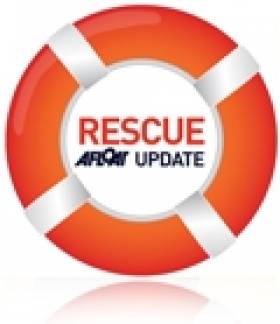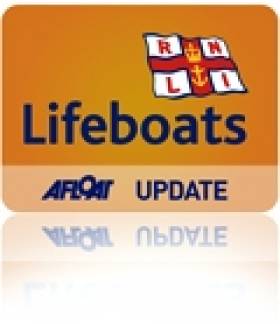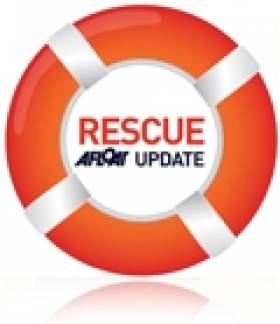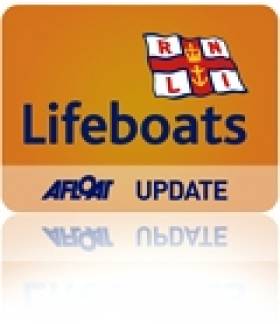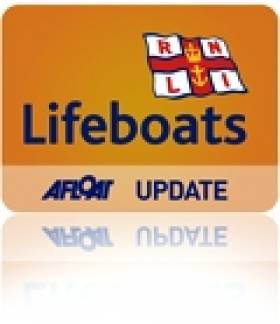Displaying items by tag: RNLI
Rescue Alert Over Trawler Mayday in Irish Sea
The News & Star reports that RNLI Workington responded to the fishermen's mayday call along with Maryport's coastguard and inshore rescue team.
Engline failure is being blamed for the incident, which occurred before 9.30am on Monday morning. The trawler has since been towed to Ireland for repairs.
Two Successful Rescues by Bangor Lifeboat
On Wednesday 22nd June at 8.20pm Belfast Coastguard received information that an 18ft speedboat with 2 persons aboard had struck rocks close to Groomsport. Volunteer crew quickly assembled and launched RNLI Bangor Lifeboat which proceeded at full speed to the stricken vessel. Thankfully the two people onboard the stranded vessel were able to scramble safely ashore before the Lifeboat arrived on scene. Crew aboard the Lifeboat rigged a tow line and towed the speedboat to the safety of Groomsport Harbour.
On Saturday 25th June at 1.15pm volunteer RNLI crew were alerted by rescue pager that a 35ft yacht with 3 people onboard had lost all steering and required assistance. Belfast Coastguard gave the vessels location as 2½ nautical miles north east of Bangor Harbour. Bangor Lifeboat was launched and escorted the sailing vessel close to entrance of Bangor Harbour were a tow line was rigged. The yacht was then towed to the safety of Bangor Marina.
Kyle Marshall, senior RNLI volunteer helmsman at Bangor Lifeboat Station took this opportunity to stress five very important sea safety tips for anyone going afloat. He said. 'Always wear a lifejacket, secondly check your engine and fuel, thirdly tell others where you are going, fourthly carry some means of calling for help and final always check the weather and tides' He added 'We're happy that the crews aboard both vessels are now safely ashore'.
Hull Damage To Blame for Stranded Divers
The accident that left four divers stranded off the Wexford coast last weekend was caused by damage to their boat's hull.
Divernet reports that the accident occurred when a section of tubing at the RIB's bow broke away from the hull.
The search operation, which included four RNLI lifeboats, an Irish Coast Guard helicopter and shore unit, was launched last Friday night when the group of divers failed to return to shore.
The divers were rescued at 6am on Saturday morning near the Saltee Islands, where they were found clinging to their upturned RIB.
Dramatic video of the divers' rescue was posted earlier this week on Afloat.ie.
Mayday Prompts Launch of Both Baltimore Lifeboats
Valentia Coast guard first raised the alert at 08:48 this morning requesting the launch of the all weather lifeboat Hilda Jarrett, 3 minutes later the inshore life boat Bessie was tasked too and with it's superior engine power was first on scene. They found the potting boat within 50 metres of the rocks at the North West point of the Western Calf Island. The fishermen had set an anchor in an attempt to keep the boat off the rocks, but the anchor had dragged and they were left holding into their pot lines for safety. A difficult task in Force 5 westerly winds with a 2 metre swell running.
Helm John Kearney manoevred the lifeboat into position and his crew threw a line to the fishermen. The lifeboat then towed the boat upwind and with the assistance of Schull inshore rescue removed the fishing boat from immediate danger.
The allweather lifeboat arrived on scene and stood by until it was clear that there was no further danger. The inshore lifeboat then towed the pot boat to the safety of Schull harbour. The fishermen were unharmed. Helm John Kearney commented ' it was fortunate we arrived when we did another 5 minutes and we would have been pulling the men out of the water'.
Inshore lifeboat Crew : Helm John Kearney, crew Ronan Callanan & Tadhg Collins
Allweather Lifeboat : Coxswain Kieran Cotter, crew Aidan Bushe, Jerry Smith, Cathal Cottrell, Anthony Sheehy, Sean Mc Carthy, Colin Whooley. Slip crew Rianne Smith, Simon Duggan, Gerard Sheehy
Five Escape When Yacht Hits Rocks Off Galway
Five sailors had a lucky escape when their yacht hit rocks off the coast of Galway in the early hours of Saturday morning, the Irish Examiner reports.
The crew of five, who had been taking part in the annual Around Aran Race, launched their liferaft when the boat ran aground and raise the alarm from the shore.
Galway's RNLI lifeboat was dispatched to the abandoned yacht in Galway Bay later that morning.
Divers Rescued off Wexford After RIB Capsizes
Four missing divers were found off the Wexford coast after a night search by RNLI lifeboats and Coast Guard. SCROLL DOWN FOR VIDEO.
Four divers have been rescued off the coast of Co Wexford today after a search involving four volunteer RNLI lifeboat crews, the Coast Guard helicopter from Waterford and shore unit.
The divers were found near the Saltee Islands just before 6am on Saturday morning (June 18), clinging to an upturned RIB boat.
The divers were expected back to shore at 10.30pm and when they didn't return a search was launched involving both the RNLI and the Irish Coast Guard. Kilmore Quay RNLI lifeboat was launched to search for the divers followed later by lifeboats from Dunmore East, Rosslare and Fethard.
The divers were spotted at first light by a Coast Guard shore team and winched to safety by the Coast Guard helicopter.
Basic Safety On the Water
Even the most experienced people with the best equipment can run into danger on the water, according to the RNLI's Irish sea safety officer.
Kevin Rahill told The Irish Times that standards are improving in terms of safety awareness, but many basic procedures are still being ignored.
"Leisure craft are unregulated, so a big part of what we do is to try to get people to increase their safety on a voluntary basis: wear a lifejacket, understand weather conditions, undertake training," he said.
Des Kearney of Deep Blue Sea kayaking highlighted that many novices will be tempted out to the water to see the dolphin pod that has recently taken residence in Dalkey.
"“My main concern is that people recognise the dangers," he said. "Once you get outside the harbour wall the winds can be very strong, and an inexperienced paddler could be swept away."
The Irish Times has more on the story, including a safety checklist, HERE.
President Mary McAleese names the first Tamar class RNLI lifeboat in Ireland at Kilmore Quay
The RNLI volunteers with Kilmore Quay lifeboat station are the first to receive the new €3 million lifeboat, which is the most modern and technically advanced lifeboat in the RNLI fleet. The new lifeboat, which is named Killarney (ON 1298) was funded by a legacy from Mrs Mary Weeks of Surrey in England who passed away in 2006.
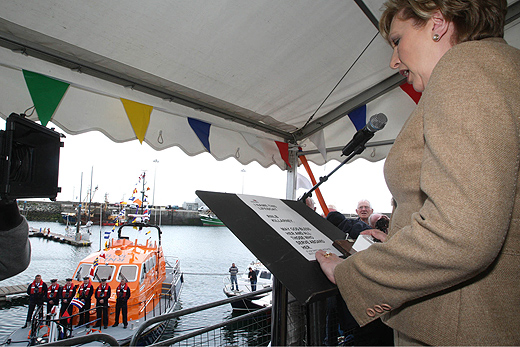
Mrs Weeks met her husband while on a cruise off the west coast of Scotland on a boat named Killarney. Mrs Weeks had a strong RNLI connection through her maiden name Distin. She was a relation of the Coxswain of Salcombe lifeboat Samuel Distin and of lifeboat crewmember Albert Distin; both men lost their lives in the Salcombe lifeboat disaster of 1916.
Mrs. Weeks' niece Mrs Betty Hull, her great niece Mrs Anne Piggford and great nephew David Hull were special guests at the ceremony. Speaking during the ceremony the President of Ireland, Mary McAleese addressed the crowds with the lifeboat alongside, " Everything that is good about human nature is gathered on this day. All the good qualities, all the things that people are capable of doing out of goodness, generosity, love, kindness, care concern; all gather around the naming of this boat this day. It comes to us by way of gift, it has been blessed and the gift itself is a blessing.

A blessing not just to those that take the boat into their ownership this day but to the people someday who will need this blessing and need its gift. For almost two hundred years now the RNLI has stories to tell of saving literally ten of thousands of lives. Tens of thousands of people who could call on the lifeboat, call on the volunteer crews and in particular without knowing it call on the generosity of people who would never get on the boat. Who like Mary Weeks would never see the boat, never live to see it but would give it as an act of generosity to future people, complete strangers who she would never know."
The new Tamar class lifeboat is 16.3 metres in length with a maximum speed of 25 knots compared to the 14.3 metres of the current Tyne class lifeboat stationed at Kilmore Quay, which has a maximum speed of 18 knots. The lifeboat is self-righting and is fitted with an integrated electronics systems and information management system, which allows the lifeboat crew to monitor, operate and control many of the boats systems from shock mitigating seats.
The Tamar also carries a Y boat (an inflatable daughter boat) which is housed under the aft deck and deployed from a hinged door in the transom. The lifeboat has room for 44 survivors.
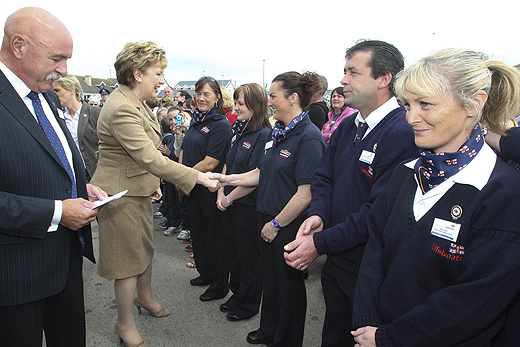
Dun Laoghaire Lifeboats Aid Three People During Boat Drama
Four people were on board the craft when they got into difficulties off Shanganagh cliffs between Killiney and Bray. One person swam to shore to raise the alarm, two clung to a buoy while another was reported missing.
The RNLI's all-weather (ALB) lifeboat and inshore lifeboat launched at 14.08pm and proceeded to the scene, arriving 15 minutes later.
Dun Laoghaire RNLI volunteer crew recovered two of the casualties on board the inshore lifeboat while the Irish Coast Guard rescue helicopter 116 located the missing person in the water. All three were transfered to the helicopter and taken to Tallaght Hospital for treatment.
Conditions were described as fresh with force four to five winds.
West Cork Lifeboats Rescue Yacht
A yacht in distress 28 miles South West of Baltimore called for assistance in the early hours of this morning. The 36ft yacht had left the Azores 11 days previously heading for Kinsale with two Danish men on board in their mid- to late sixties. The all weather lifeboat Hilda Jarrett, was launched at 02:10 in gale force weather conditions with a 3-4 metre swell from the South East
Radio contact was established within half an hour. The yacht was in serious peril. Her engines were disabled, one of the crew was suffering from prolonged sea-sickness since leaving the Azores and the remaining crew had not slept in 48 hours.
The yacht was sailing North under reefed mainsail using self steering gear. It was impractical to tow the yacht back into the wind, In the light of day, Coxswain Eoin Ryan, skillfully maneuvered, the 47ft lifeboat alongside the yacht, to allow the safe transfer of Mechanic Cathal Cotrell who had bravely volunteered to go onboard. Cathal who is an experienced sailor was able to take control of the yacht.
Meanwhile the coastguard had mobilized Castletownbere lifeboat which arrived on scene at 5:15 approx and established a tow with the yacht. The yacht was towed to safety with Cathal Cottrel at the helm of the yacht, arriving in Castletownbere at 08:00. One of the men received medical attention locally on arrival.
Baltimore lifeboat made the 20 mile passage to Baltimore arriving back on station at 8:30
Cox Eoin Ryan, Mechanic: Cathal Cotreel, Crew: Gerry Smith, Colin Whooley, Sean McCarthy, Brian McSweeney.
Micheal Cottrel, Vincent Roantree, Donal O'Donovan and Jason Pavry provided shore support .


























